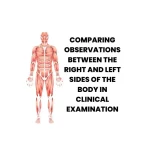Clinical examination is a fundamental aspect of healthcare, enabling medical professionals to assess patients, diagnose conditions, and provide appropriate treatment.
In the process of clinical examination, effective communication and accurate reporting are crucial.
One common practice that medical professional is encouraged to avoid is using the term ‘normal’ when describing findings.
Instead, they should provide a detailed description of the observed phenomenon.
In this comprehensive discussion, we will explore in detail why it is essential for medical professionals to refrain from using the term ‘normal’ during clinical examinations.
Through a thorough analysis and illustrative examples, we will delve into the reasons behind this practice and its significance in modern healthcare.

Table of Contents
ToggleTHE PROBLEM WITH 'NORMAL'
To understand why the use of the term ‘normal’ is discouraged in clinical examination, we must first examine the limitations and potential pitfalls associated with this term.
In medical practice, ‘normal’ is a highly subjective and context-dependent concept.
What may be considered normal for one patient might be abnormal for another.
Here are some key reasons why the term ‘normal’ can be problematic:
Variability Among Individuals:
Human bodies exhibit considerable natural variability.
Factors such as age, gender, genetics, and overall health can significantly influence what is considered normal for an individual.
For instance, a normal blood pressure reading for a young adult may differ from that of an elderly person.
Changing Health Status:
What is normal for a patient at one point in time may not be normal at another due to changes in their health status.
For instance, a normal blood glucose level for a non-diabetic person may not be normal for the same individual after developing diabetes.
Diagnostic Challenges:
The term ‘normal’ can lead to diagnostic challenges, as it does not provide specific, quantifiable information.
It can be vague and open to misinterpretation, making it less helpful for clinical decision-making.
Communication Barriers:
The use of ‘normal’ can lead to miscommunication and misunderstandings between healthcare professionals.
Different clinicians may interpret ‘normal’ differently, potentially leading to inconsistencies in patient care.
Patient Understanding:
Patients may find the term ‘normal’ confusing or disconcerting, as it does not provide a clear picture of their health status.
This lack of clarity can lead to anxiety or uncertainty about their condition.
Given these limitations and potential drawbacks, it becomes evident why the term ‘normal’ should be replaced with precise and descriptive language in clinical examination.
THE IMPORTANCE OF DESCRIPTIVE LANGUAGE
Descriptive language in clinical examination involves providing a detailed account of the observed findings, including measurements, characteristics, and relevant context.
This approach offers several advantages over simply labelling something as ‘normal’:
Precision:
Descriptive language allows healthcare professionals to communicate specific details about a patient’s condition.
Instead of relying on vague terms like ‘normal,’ they can use quantifiable measurements and characteristics.
Clarity:
Precise descriptions offer clarity to both healthcare professionals and patients.
Everyone involved in the patient’s care can have a clear understanding of the findings, reducing the risk of misinterpretation.
Individualized Assessment:
Descriptive language takes into account the individual patient’s characteristics and circumstances.
It acknowledges that what may be normal for one person may not be for another, ensuring personalized care.
Accurate Documentation:
Descriptive language aids in accurate documentation of patient information.
This documentation is essential for tracking changes in a patient’s condition over time, evaluating treatment effectiveness, and sharing information with other healthcare providers.
Enhanced Communication:
Healthcare professionals can convey findings more effectively when using descriptive language.
This is particularly important in interdisciplinary settings where different specialists collaborate on patient care.
Lorem ipsum dolor sit amet, consectetur adipiscing elit. Ut elit tellus, luctus nec ullamcorper mattis, pulvinar dapibus leo.
EXAMPLES OF DESCRIPTIVE LANGUAGE IN CLINICAL EXAMINATION
To illustrate the importance of descriptive language, let’s explore some examples of how medical professionals can describe findings instead of using the term ‘Normal’:
Blood Pressure:
Instead of saying “The patient’s blood pressure is normal,” describe it as “The patient’s blood pressure reading is 120/80 mm Hg, within the typical range for their age and gender.”
Temperature:
Instead of saying “The patient’s temperature is normal,” describe it as “The patient’s oral temperature is 98.6°F (37°C), which falls within the normal range for adults.”
Heart Rate:
Instead of saying “The patient’s heart rate is normal,” describe it as “The patient’s resting heart rate is 72 beats per minute, within the expected range for their age.”
Laboratory Results (e.g., Haemoglobin A1c):
Instead of saying “The patient’s HbA1c is normal,” describe it as “The patient’s Haemoglobin A1c level is 5.3%, indicating well-controlled blood glucose levels for a non-diabetic individual.”
Physical Examination (e.g., Skin Lesion):
Instead of saying “The skin lesion appears normal,” describe it as “The skin lesion measures 1 cm in diameter, has regular borders, and exhibits uniform pigmentation, suggesting it is likely benign.”
Radiological Findings (e.g., Chest X-ray):
Instead of saying “The chest X-ray shows normal lung fields,” describe it as “The chest X-ray reveals clear lung fields without any signs of infiltrates or opacities, consistent with a healthy respiratory system.”
By using descriptive language in these examples, healthcare professionals provide a more accurate and informative assessment of the patient’s condition, ensuring that the findings are both meaningful and actionable.
BENEFITS OF AVOIDING 'NORMAL' IN CLINICAL EXAMINATION
Enhanced Diagnostic Precision:
Descriptive language allows for a more precise and subtle evaluation of a patient’s health. Healthcare professionals can identify minor abnormalities or deviations from baseline more effectively.
Personalized Patient Care:
Patients receive individualized care tailored to their specific circumstances.
Descriptive language takes into account variations in patient demographics, medical history, and current health status.
Clear Communication:
Healthcare professionals can communicate findings clearly and unambiguously, reducing the risk of misinterpretation among colleagues and patients.
Facilitation of Treatment Decisions:
Detailed descriptions of findings support informed treatment decisions.
Clinicians can develop targeted and evidence-based treatment plans based on specific observations.
Comprehensive Documentation:
Accurate and descriptive documentation is essential for maintaining thorough and reliable patient records.
It ensures that healthcare providers have access to complete and detailed information for ongoing care.
Patient Empowerment:
Patients benefit from a clearer understanding of their health status when findings are described in detail.
This transparency empowers them to actively participate in their care and make informed decisions.
Interdisciplinary Collaboration:
In multidisciplinary healthcare settings, descriptive language fosters effective communication among specialists with diverse backgrounds, promoting collaborative patient care.
Research and Education:
Descriptive language supports medical research and education by providing rich data for analysis and case studies. It contributes to the advancement of medical knowledge and training.
EXAMPLES OF THE IMPACT OF DESCRIPTIVE LANGUAGE
To further emphasize the impact of descriptive language, let’s examine scenarios where precise descriptions have significant implications for patient care:
Scenario 1: Respiratory Assessment A nurse conducts a respiratory assessment on a patient recovering from surgery. Instead of using the term ‘normal’ to describe the patient’s breath sounds, the nurse provides a detailed description: “During auscultation, clear vesicular breath sounds were heard bilaterally in all lung fields. No adventitious sounds, such as crackles or wheezes, were detected.”
Impact: The detailed description indicates normal lung function and the absence of respiratory issues. If the nurse had used the term ‘normal’ without additional information, subtle abnormalities might have been missed, potentially delaying necessary interventions.
Scenario 2: Cardiac Examination A cardiologist evaluates a patient’s heart sounds during a routine checkup. Instead of saying “The heart sounds are normal,” the cardiologist provides a specific description: “S1 and S2 heart sounds are audible, with no murmurs, gallops, or extra heart sounds detected. The rhythm is regular at 72 beats per minute.”
Impact: The cardiologist’s description confirms a healthy cardiovascular system, allowing for the timely identification of any abnormalities if present. The detailed assessment contributes to early intervention and preventive care.
Scenario 3: Dermatological Assessment A dermatologist examines a patient’s skin for signs of skin cancer. Rather than stating “The skin appears normal,” the dermatologist uses descriptive language: “The skin exhibits even pigmentation, regular borders, and uniform texture. No suspicious moles, lesions, or asymmetry are observed.”
Impact: The dermatologist’s detailed description reassures the patient about the absence of concerning skin changes. If the description were limited to ‘normal,’ the patient might remain uncertain about their skin health, potentially causing undue anxiety.
FAQs:
Q1: Is it always necessary to provide detailed descriptions in clinical examination, or are there situations where ‘normal’ is sufficient?
A1: While detailed descriptions are encouraged for accuracy, there may be instances where ‘normal’ suffices. However, providing context and quantifiable data is generally preferred.
Q2: Are patients generally receptive to detailed descriptions of their health findings, or do they prefer simpler explanations?
A2: Patients appreciate clear and informative explanations. Descriptive language can help patients better understand their health status and make informed decisions.
Q3: How can healthcare professionals ensure consistency in using descriptive language across different specialties and institutions?
A3: Standardized guidelines and protocols for clinical reporting can help maintain consistency in the use of descriptive language across the healthcare industry.
Q4: Are there any cultural or language considerations when using descriptive language in healthcare, especially with diverse patient populations?
A4: Healthcare professionals should be sensitive to cultural and language differences. Providing explanations in a culturally competent and patient-friendly manner is essential.
CONCLUSION
In clinical examination, the use of the term ‘normal’ should be avoided in Favor of descriptive language that provides specific, quantifiable information about observed findings. This practice is essential for several reasons:
- It ensures precision and clarity in communication.
- It supports individualized patient care and informed decision-making.
- It facilitates interdisciplinary collaboration and research.
- It empowers patients to actively engage in their healthcare.
By adopting descriptive language, healthcare professionals contribute to more accurate diagnoses, effective treatments, and improved patient outcomes.
The practice aligns with the principles of modern medicine, where comprehensive and personalized care is paramount.
In conclusion, embracing precise and descriptive language in clinical examination is not merely a linguistic preference; it is a fundamental aspect of delivering high-quality healthcare.













Leave a Reply